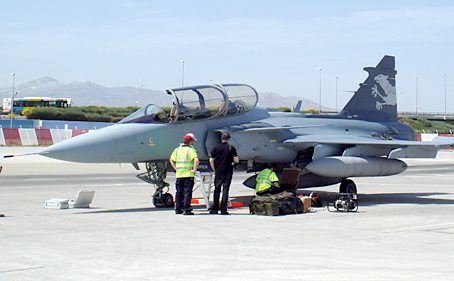Saab Aerospace’s Gripen fighter continues to be the single application for Volvo’s RM12 engine. By the end of 2010, the Gripen had a 23-aircraft backlog. Based on current delivery schedules, this backlog will push production into 2013.
In the absence of any new orders, Saab will be concentrating on upgrading the Gripens of Sweden’s Air Force to the C/D standard. Saab is offering an updated variant of the fighter (Gripen NG) for fighter competitions in Brazil, Bulgaria, Denmark, Greece, India, the Netherlands, Romania, Slovakia, and Switzerland.
One of the elements of the Gripen NG program is a higher thrust engine. Saab has been testing a 22,000-lbst GE F414G in place of the RM12. The higher thrust gives the Gripen supercruise capability and a higher weapon payload and fuel capacity, thereby increasing range. The other elements to the NG program are an upgraded radar and avionics.
Once production of the RM12-powered Gripen has ended, we expect Volvo to support the existing fleet by continuing to produce engine modules and spares.
Snecma M88 Faces Cuts in Dassault’s Rafale Program
The Snecma M88’s fate is based on the Dassault Rafale fighter, which is the single application for the engine. Through December 2010, the French government ordered a total of 180 Rafales, but in 2009 Dassault announced its production rate would drop from 14 aircraft annually to 11, and that this decline would continue through 2016. This move was made to slow the delivery of the French military’s new Rafales, which are competing with the existing Mirage fleet, 50 of which are undergoing a midlife upgrade. The upgrade of the Mirages may mean a reduction in the new fighter requirement to 250 aircraft from the current 294.
To date, the French government has ordered 180 aircraft; in December 2009, the last multiyear purchase contract known as Tranche 4 was announced. It is expected that Tranche 4 will cover aircraft production from 2013-2017. These aircraft will have the upgraded M88-4E engine (formerly known as the TCO Pack), which incorporates a modified high-pressure compressor and turbine. The goal of the durability development program has been to extend the engine’s service life and time between inspections. Production of the M88-4E is expected to begin late in 2011.
Eurojet EJ200 Supports Eurofighter Program
The Eurojet EJ200 continues in production for its single application, the Eurofighter Typhoon. Of the three planned production batches, the first two cover the first 384 aircraft; tranche 1 production ended in 2008 and tranche 2 will continue into 2013. Tranche 3 has been split into A and B groups, with the 3A group accounting for 112 aircraft.
The question is what will happen with tranche 3B, as defense budgets in the four partner countries are under pressure and a reduction in aircraft purchases may be inevitable. The signing of the tranche 3B contracts is due to occur in 2011, and at the start of the year the prospects of an order were rather grim. As such, production of the 3A aircraft will be completed in 2016-2017.
The Eurofighter has been a slow seller on the export market. The initial order for 72 aircraft from Saudi Arabia will probably have no follow-up, as the kingdom announced plans to order 84 new F-15Es. India is still a promising potential customer with its 126-aircraft requirement, and Turkey may need up to 100 aircraft to replace its 120 F-4s. Japan may take a serious look at the Typhoon for its 50-aircraft requirement, as efforts to purchase Lockheed Martin’s F-22 have been blocked by the U.S. Congress.
Eurofighter and its partners have been studying the idea of a naval variant of the Typhoon. In addition to the structural strengthening required to modify the aircraft for carrier operations, Eurofighter believes a thrust-vectoring version of the EJ200 would allow for the necessary lower approach speeds and resultant lower structural landing loads. The company says thrust vectoring could be integrated into the aircraft’s advanced flight control system.










